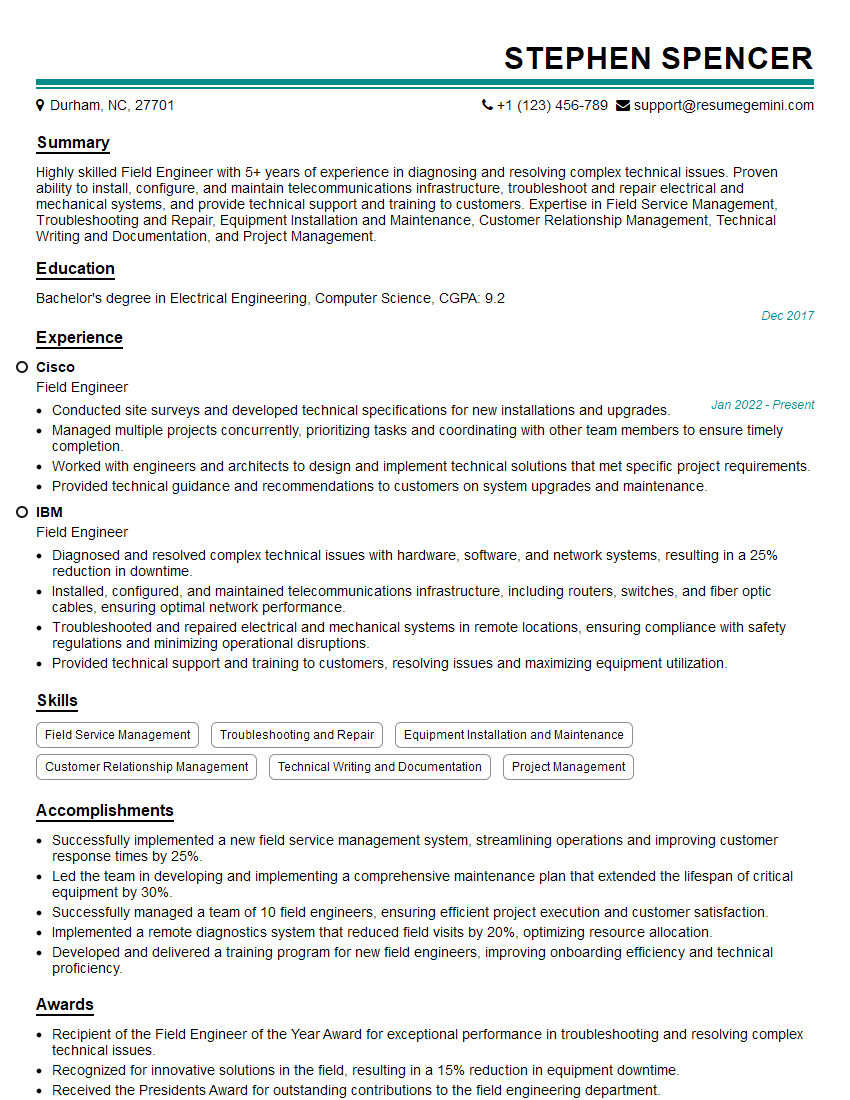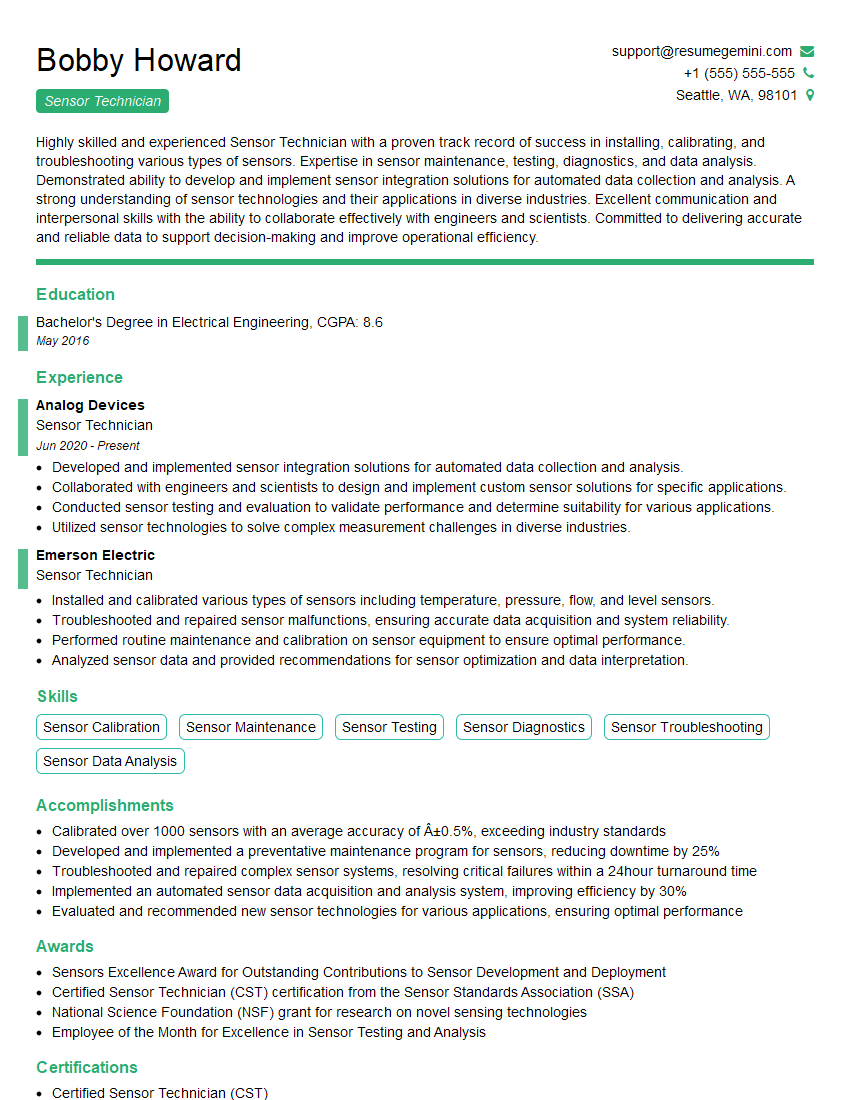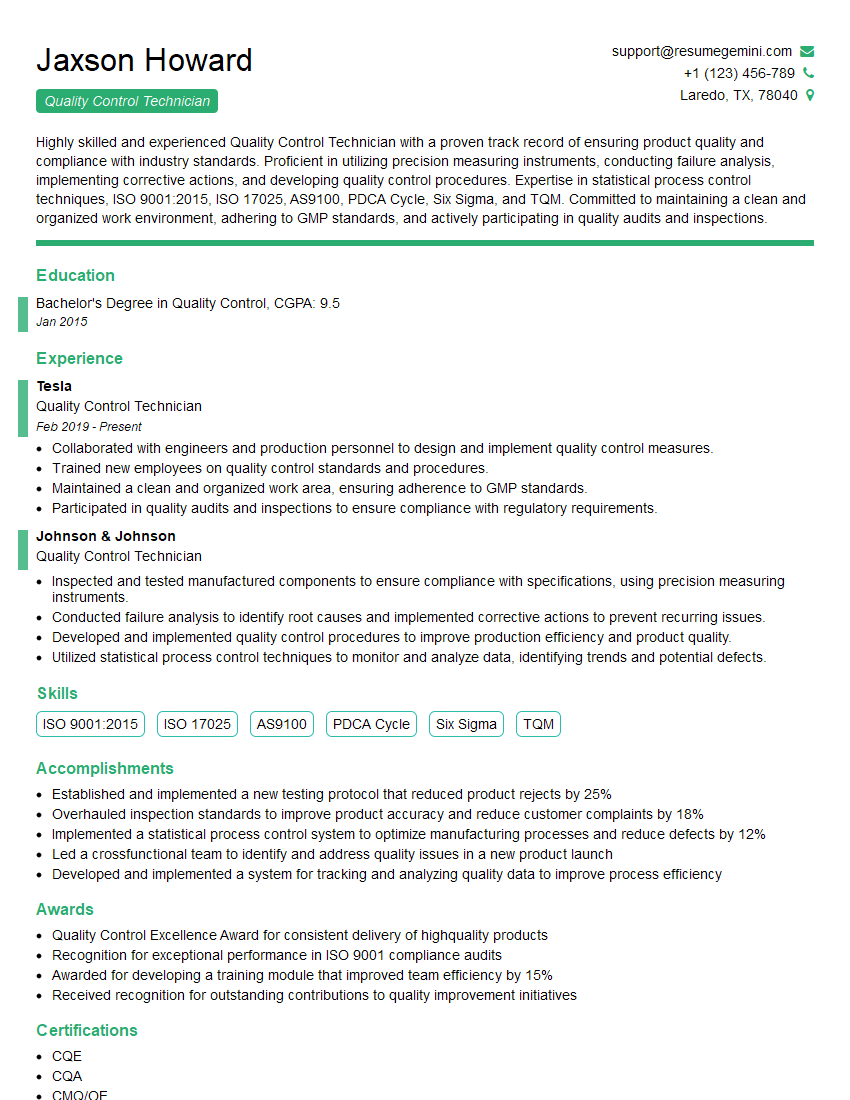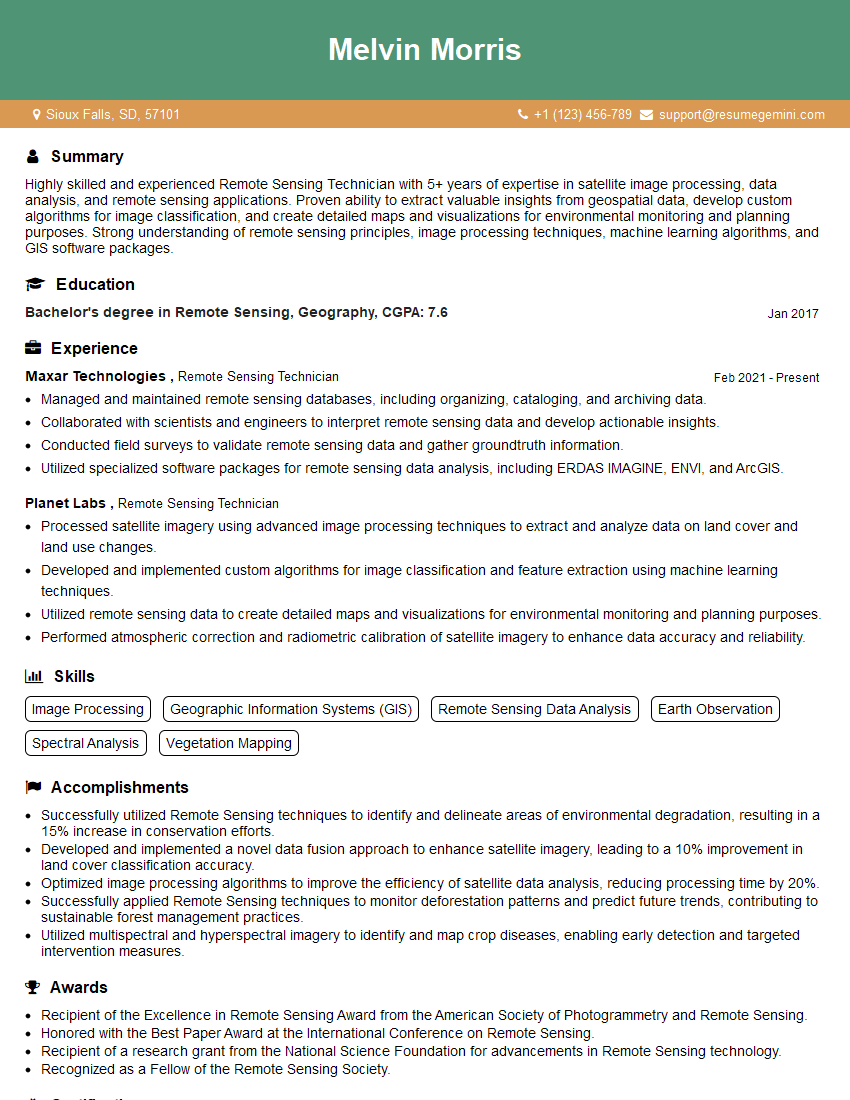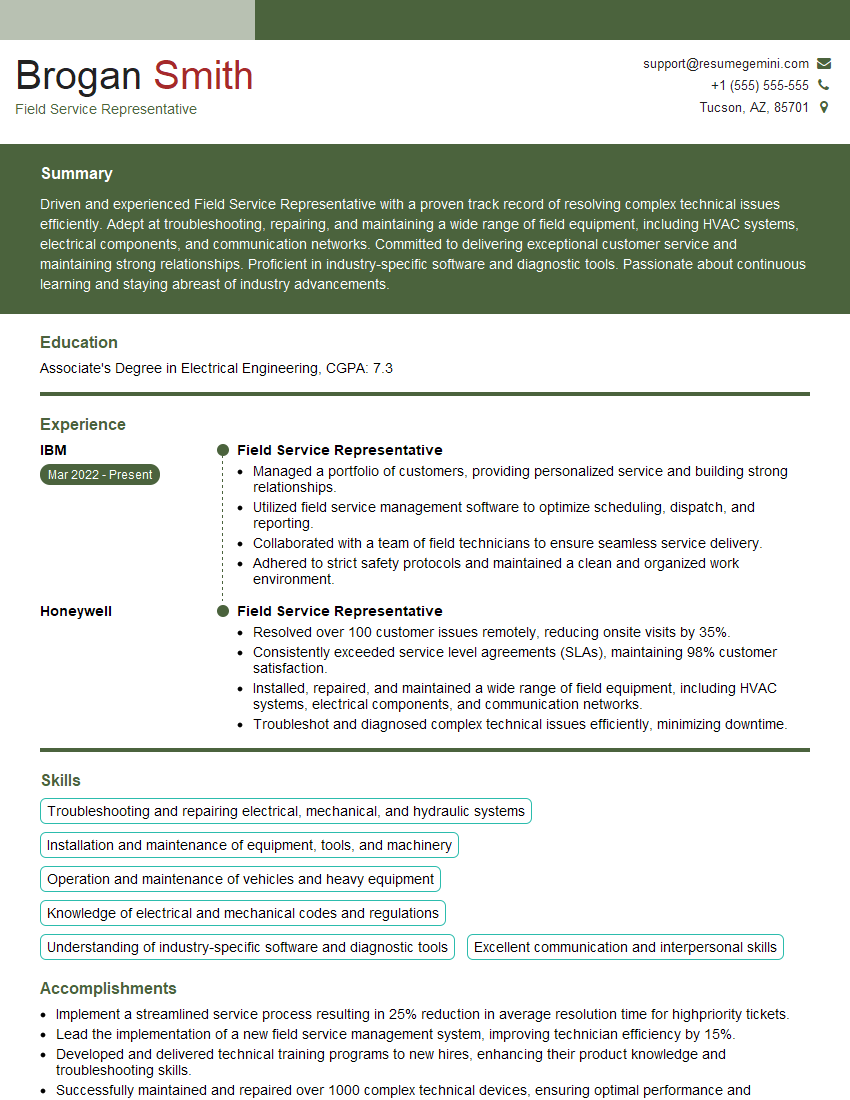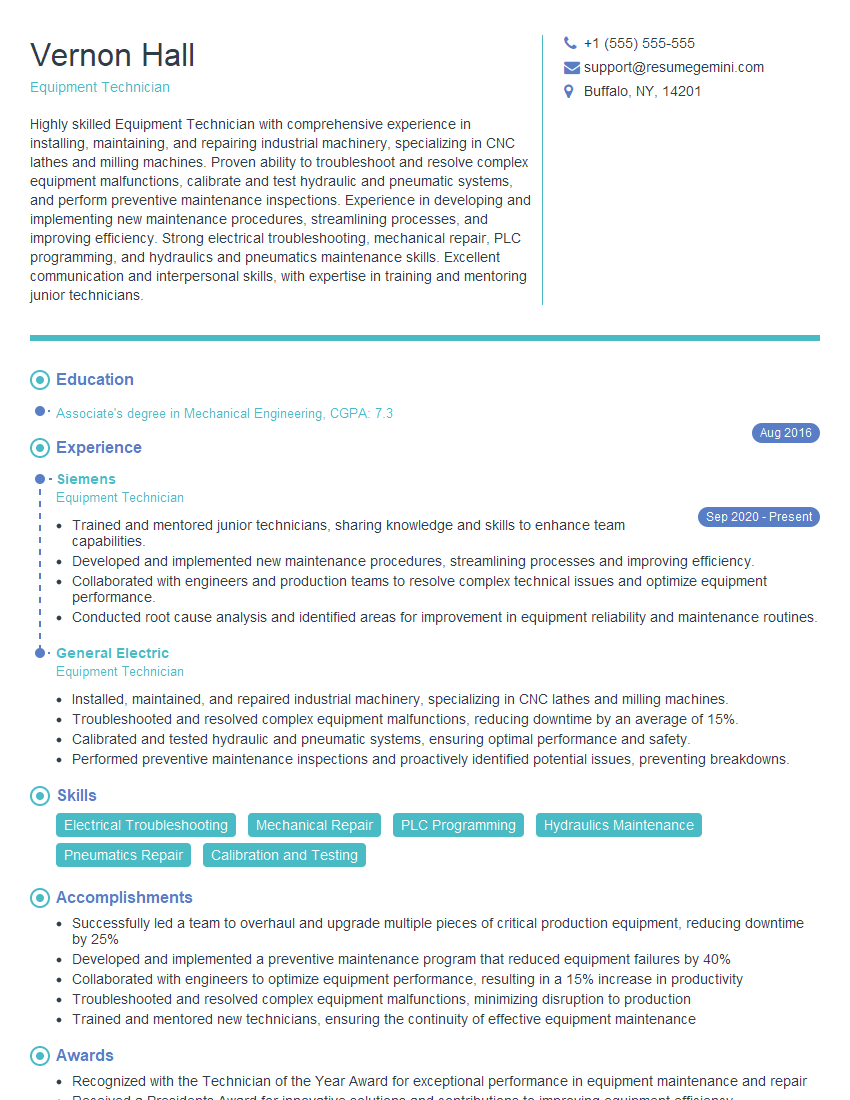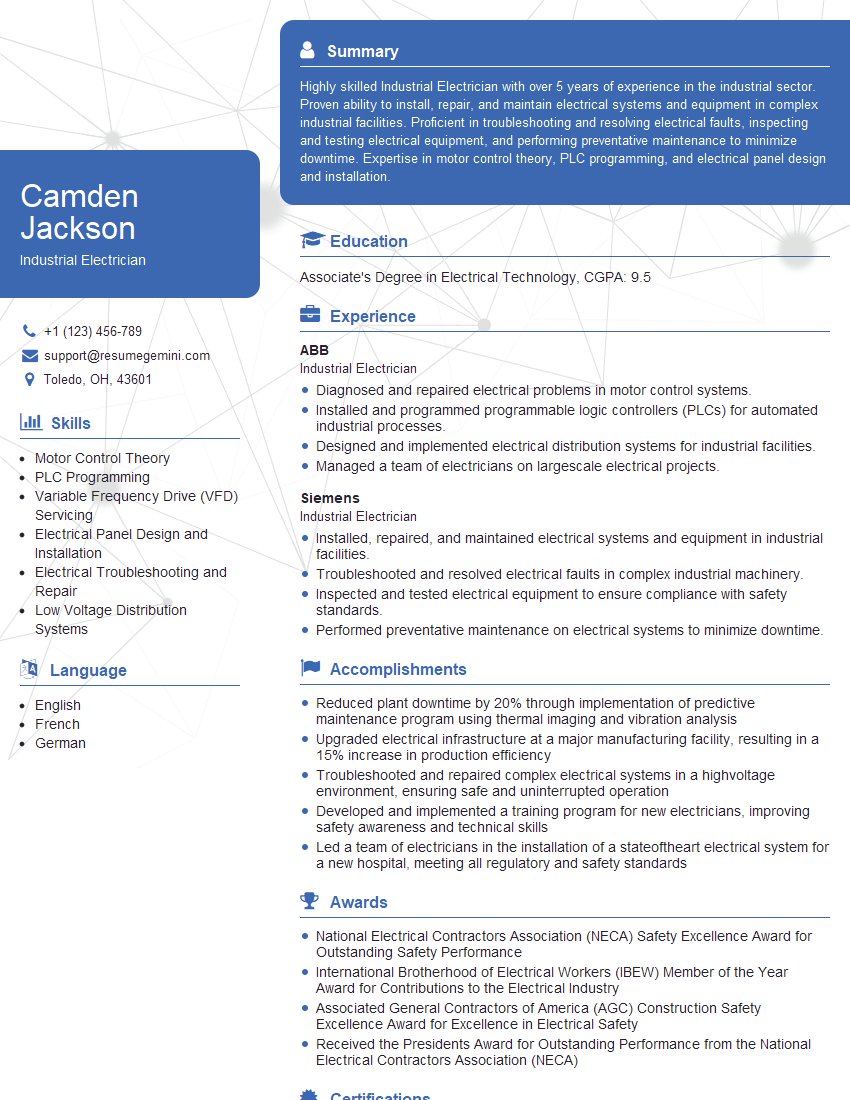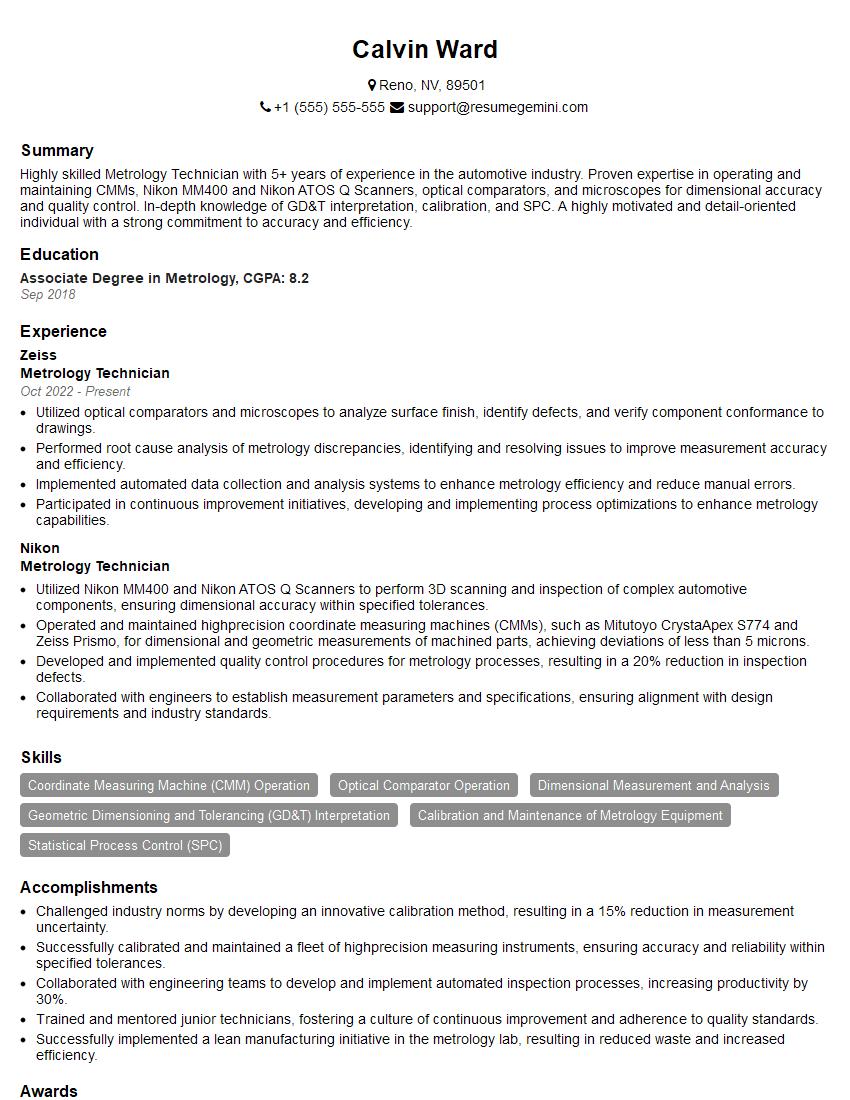The right preparation can turn an interview into an opportunity to showcase your expertise. This guide to Proficient in using data loggers and handheld field devices interview questions is your ultimate resource, providing key insights and tips to help you ace your responses and stand out as a top candidate.
Questions Asked in Proficient in using data loggers and handheld field devices Interview
Q 1. Describe your experience with different types of data loggers.
My experience spans a wide range of data loggers, from simple temperature sensors to sophisticated multi-parameter units capable of recording environmental data, pressure, strain, and more. I’ve worked with both standalone loggers with internal memory and those that transmit data wirelessly in real-time. For instance, I’ve extensively used Campbell Scientific CR1000 series loggers for long-term ecological monitoring projects, recording soil moisture, air temperature, and relative humidity. These are robust and reliable, ideal for harsh field conditions. I also have experience with smaller, more compact devices like HOBO data loggers, perfect for quick deployments and simpler data acquisition needs. My experience also includes working with loggers that interface with various sensors, requiring knowledge of sensor calibration and signal conditioning.
- Standalone loggers: These record data locally and require manual download.
- Wireless loggers: These transmit data remotely, often using cellular or satellite communication, allowing for real-time monitoring.
- Multi-parameter loggers: These can record various parameters simultaneously, optimizing fieldwork efficiency.
Q 2. Explain the process of calibrating a data logger.
Calibrating a data logger is crucial for ensuring accurate measurements. The process varies slightly depending on the logger and the type of sensor used. Generally, it involves comparing the logger’s readings to a known standard. For example, for a temperature logger, you would use a calibrated thermometer traceable to a national standard.
The steps usually include:
- Preparation: Gather necessary equipment, including the data logger, calibration standards, and any required software.
- Setup: Stabilize the logger and calibration standard at a specific temperature or other relevant parameter.
- Measurement: Allow the logger and standard to reach thermal equilibrium before taking readings at several known points (e.g., 0°C, 25°C, 50°C for a temperature logger).
- Comparison: Compare the logger’s readings to those of the calibration standard. This may involve using calibration software provided by the manufacturer.
- Correction: Apply the necessary corrections to the logger’s data, often through software, to compensate for any discrepancies. This might involve creating a calibration curve.
- Documentation: Meticulously document the calibration process, including dates, times, temperatures (or other relevant parameters), and any corrections applied.
Failing to properly calibrate a data logger can lead to inaccurate data, potentially impacting the validity of any conclusions drawn from the project.
Q 3. How do you troubleshoot connectivity issues with a handheld field device?
Troubleshooting connectivity issues with handheld field devices can be systematic. First, I’d check the most obvious:
- Battery level: A low battery can severely impair communication.
- Power source: If it uses an external power supply, ensure it’s properly connected and functioning.
- Physical connection: If it’s a wired connection, check for loose cables or damaged ports.
- Software issues: Make sure the device’s firmware is up-to-date and compatible with the receiving software/system. Restarting both the device and the receiving computer often helps.
- Wireless interference: If it’s a wireless connection, investigate any potential sources of interference (other wireless devices, electromagnetic fields, etc.). Changing channels or moving the device might solve the problem.
- Network connectivity: For cellular or Wi-Fi connections, check the network signal strength, and verify your network settings.
If the issue persists, I would consult the device’s manual or contact technical support for further assistance.
For example, in one project, I encountered connectivity issues with a GPS-enabled handheld device due to a faulty antenna. Replacing the antenna solved the problem immediately.
Q 4. What data formats are you familiar with for data loggers (e.g., CSV, TXT, etc.)?
I’m proficient in handling various data formats commonly used by data loggers. The most frequent are:
- CSV (Comma Separated Values): A simple, widely compatible text-based format excellent for importing into spreadsheets and databases. Each line represents a data point, with values separated by commas.
- TXT (Text Files): Generic text files, often used for simpler data, where the format might be less standardized.
- DAT (Data Files): Proprietary formats specific to certain data logger manufacturers. They often require specialized software for analysis.
- Excel (XLS, XLSX): Microsoft Excel’s spreadsheet formats; many loggers can directly output data in this format.
Understanding these formats is vital for data processing and analysis. Choosing the appropriate format depends on the complexity of the data, the software used for analysis, and the need for compatibility across different platforms.
Q 5. How do you ensure data integrity when using data loggers?
Data integrity is paramount when using data loggers. Several measures ensure this:
- Regular calibration: As described earlier, calibration ensures accurate measurements.
- Data validation: Checking for outliers or inconsistencies in the data; this often requires plotting the data and visually inspecting it.
- Redundancy: Deploying multiple loggers to measure the same parameter; if one fails, data from others provide backup.
- Data logging frequency: Choosing an appropriate sampling rate to capture important variations without excessive data volume.
- Secure data storage: Using reliable storage methods, including backups to prevent data loss.
- Metadata: Meticulously documenting all relevant information about the data, including the logger’s location, calibration details, and any potential sources of error.
- Chain of custody: Maintaining a clear record of who handled the data and when, crucial for accountability.
For instance, in a water quality monitoring project, we deployed duplicate loggers to ensure redundancy and prevent data loss due to equipment failure or unexpected events.
Q 6. Explain the importance of proper data logger placement.
Proper data logger placement is critical for obtaining accurate and representative data. Incorrect placement can lead to significant errors and misinterpretations. Key considerations include:
- Environmental factors: Shielding the logger from direct sunlight, rain, or extreme temperatures; depending on the parameter, shading or insulation might be necessary.
- Location: Choosing a location representative of the area being monitored, avoiding microclimates or other localized effects.
- Accessibility: Ensuring easy access for maintenance, data retrieval, and recalibration.
- Security: Protecting the logger from theft or vandalism.
- Substrate/support: Using appropriate supports and mounting techniques to ensure the logger remains stable and securely positioned.
For example, if monitoring soil moisture, the logger should be placed at a consistent depth, and the probe should be inserted without disturbing the soil structure. If air temperature is being measured, the logger needs to be sheltered from direct sunlight to avoid overestimation.
Q 7. What are the common problems encountered while using handheld devices in the field?
Common problems encountered with handheld devices in the field often relate to harsh environmental conditions:
- Battery life: Limited battery life, especially in cold or hot conditions. Always carry spare batteries.
- Screen visibility: Difficulty reading the screen in bright sunlight or low light conditions. Consider using a screen protector or carrying an external light source.
- Physical damage: Accidental drops, impacts, or exposure to water or dust can cause damage. Protective cases are essential.
- Connectivity issues: As mentioned earlier, interference or poor signal strength can hinder data transfer.
- Software glitches: Unexpected software errors can disrupt data collection. Regularly backing up data and keeping the software updated is crucial.
- User error: Incorrect handling or operation of the device can lead to data errors.
Robust device selection, proper training, and preventative maintenance are crucial to minimizing these issues and ensuring reliable data acquisition in the field.
Q 8. How do you handle corrupted data from a data logger?
Dealing with corrupted data from a data logger is unfortunately a common occurrence. The first step is always prevention – ensuring robust data logging practices, like regular data backups and using error-checking protocols. However, when corruption happens, my approach is systematic and methodical. I begin by identifying the extent of the corruption. Is it a single data point, a section of the log file, or the entire file? This assessment guides my next steps.
For minor corruptions, I might attempt data repair techniques using specialized software provided by the data logger’s manufacturer. These tools often include algorithms designed to identify and correct inconsistencies in the data. For example, if there’s a single outlier value that’s clearly erroneous, I’d analyze the surrounding data points to identify a plausible replacement based on trends or known patterns. If the data logger itself has error logging capabilities, I’d examine those logs for clues about the cause of corruption.
If the corruption is extensive, repair might not be feasible. In those cases, my strategy focuses on data recovery and mitigation. I might look for backup copies of the data. If backups exist, I’ll use the latest valid copy and document the loss of the corrupted data. If no backups exist, I might try to salvage partial information from the corrupted files. Finally, I’d thoroughly investigate the cause to prevent future incidents. This could involve checking the data logger’s health, verifying power supply stability, and reviewing environmental conditions to ensure they were within operational limits. This rigorous process helps maintain data integrity and trust in my collected data.
Q 9. Describe your experience with different communication protocols used in data loggers (e.g., RS-232, RS-485, Modbus).
I’ve extensive experience with various communication protocols frequently used with data loggers. Each has its strengths and weaknesses, making selection crucial for specific applications. For instance, RS-232 is a simple, point-to-point serial communication protocol, commonly used for shorter distances and lower data rates. It’s straightforward to implement but susceptible to noise and interference, limiting its range. I’ve used this successfully for connecting a single data logger to a nearby computer for direct data download.
RS-485, in contrast, is a multi-point, differential signaling protocol capable of transmitting data over longer distances and with greater noise immunity than RS-232. This is crucial for situations where multiple data loggers are connected to a single central point. This feature is useful in remote monitoring scenarios like environmental monitoring stations spread across a wide area.
Modbus is a robust, widely adopted communication protocol, particularly prevalent in industrial automation. It offers reliable data transfer across various media like RS-485, Ethernet, or even TCP/IP. I’ve used Modbus extensively in industrial settings, where multiple devices (PLCs, sensors, and data loggers) need to communicate and share data within a control system. Understanding the nuances of each protocol is critical for efficient data acquisition and system integration. Knowing when to use which protocol ensures that the data collection process is efficient, robust, and reliable.
Q 10. How do you select the appropriate data logger for a specific application?
Selecting the right data logger requires careful consideration of several factors. The most critical aspect is the specific application’s requirements. What parameters need to be measured? What is the required sampling rate? What is the duration of the measurement? What is the expected range of values? What is the environment like (temperature, humidity, pressure)? The answers to these questions dictate the necessary specifications.
For example, if I need to monitor temperature in a harsh industrial setting with extreme temperatures and potential vibrations, I’d need a ruggedized data logger with a wide temperature operating range and a robust construction. Conversely, for a simple laboratory experiment, a less robust and possibly less expensive model may suffice. Another key aspect is the data logger’s memory capacity. The total amount of data to be collected directly impacts memory requirements. Wireless capabilities, battery life, and communication protocols are additional considerations, depending on the specific monitoring situation and the location of the data logger.
I also consider the software compatibility. The data logger’s software should be compatible with my existing systems and allow for seamless data import, analysis, and reporting. Careful consideration of all these factors ensures that the chosen data logger meets the application’s demands and delivers accurate, reliable data.
Q 11. What safety precautions do you take when working with field devices and data loggers?
Safety is paramount when working with field devices and data loggers. My safety procedures are guided by a combination of best practices, relevant safety regulations (OSHA, etc.), and site-specific risk assessments. Before deploying or working with any device, I perform a thorough pre-job safety assessment, identifying potential hazards.
This includes assessing electrical hazards (proper grounding, isolation procedures), environmental hazards (extreme temperatures, hazardous materials, confined spaces), and mechanical hazards (moving parts, pinch points). I always use appropriate personal protective equipment (PPE), such as safety glasses, gloves, and safety footwear, as needed. When working with electrical devices, I’d use lockout/tagout procedures to prevent accidental energization.
I always follow the manufacturer’s instructions and safety guidelines meticulously. For instance, I never attempt repairs on devices without proper training and authorization. If a device shows signs of malfunction, I take it out of service and report it immediately. Moreover, I maintain meticulous records of my work, including safety measures taken and any issues encountered. This approach ensures the safety of myself and others involved in data acquisition.
Q 12. Explain your experience with data logger software and its functionalities.
My experience with data logger software is extensive, covering various software packages from different manufacturers. These software packages usually offer a wide range of functionalities, including data visualization, configuration, and analysis. Data visualization tools allow me to plot the collected data in various formats (graphs, charts, tables) to identify trends, anomalies, and correlations. This is crucial for data interpretation and decision-making.
Configuration features allow me to customize the data logger’s settings (sampling rate, alarm thresholds, data logging intervals) remotely. This functionality eliminates the need for manual on-site adjustments. Data analysis capabilities usually include functions like calculating statistical parameters (mean, standard deviation, etc.), performing data filtering, and exporting data in various formats (CSV, Excel, etc.). This capability streamlines the data analysis process.
For example, I’ve used software that allows me to create custom reports summarizing the collected data, and even to automatically send alerts via email or SMS if certain predefined thresholds are breached. This level of automation enhances efficiency and improves real-time monitoring capabilities. Proficiency in using such software is essential for effective data management and insightful analysis.
Q 13. How do you manage large datasets collected from multiple data loggers?
Managing large datasets from multiple data loggers requires a structured approach and the right tools. I typically begin by implementing a consistent data naming convention for all files. This ensures clear identification and simplifies data organization. I then use database management systems (DBMS) or specialized data logging software capable of handling large datasets and multiple data sources. These systems allow me to import and consolidate data from various sources into a central repository. This centralized system helps streamline data management and analysis.
Data preprocessing is crucial. This step involves cleaning the data to remove any inconsistencies or errors, handling missing data, and potentially transforming data into a more suitable format for analysis. I might use scripting languages like Python with libraries such as Pandas and NumPy to automate this process, particularly for large datasets. Data visualization tools are then instrumental in understanding the large datasets and identifying patterns or anomalies in the data.
A well-defined data management plan, combined with efficient data analysis tools, are critical for managing and interpreting large datasets effectively. This systematic approach ensures data quality, simplifies analysis, and prevents confusion and errors that can arise when handling vast amounts of information from various sources.
Q 14. Describe your experience with data logger maintenance and repair.
Data logger maintenance and repair vary depending on the specific device and its operating environment. Preventive maintenance is essential and includes regularly inspecting the device for physical damage, checking connections, and verifying battery levels. I also calibrate the data logger periodically, especially if it’s used for critical measurements, following the manufacturer’s calibration instructions carefully and maintaining accurate calibration records.
Troubleshooting requires a systematic approach. I start by reviewing the device’s error logs or diagnostic messages to pinpoint the source of the problem. I then check power supply, communication connections, and sensor functionality. Simple issues, such as loose connections, can often be easily resolved. More complex problems might require deeper diagnostics, potentially involving specialized testing equipment.
For more significant repairs, I’d usually contact the manufacturer or a qualified technician. Keeping detailed maintenance logs, including dates of maintenance, calibration records, and repairs performed, is essential for device longevity and data reliability. This proactive approach minimizes downtime and ensures the continued accuracy and operational reliability of the data loggers in the field.
Q 15. How do you ensure the accuracy and precision of data collected by data loggers?
Ensuring accurate and precise data from data loggers involves a multi-step process that begins before deployment and continues through data analysis. Accuracy refers to how close the measured value is to the true value, while precision refers to the repeatability of measurements.
- Pre-deployment Calibration: Before deploying any data logger, it’s crucial to calibrate it against a known standard. This involves comparing its readings to a highly accurate instrument and adjusting its settings accordingly. For instance, a temperature data logger might be calibrated against a certified thermometer.
- Sensor Selection and Placement: Choosing the right sensor for the application is paramount. Factors like range, accuracy, resolution, and environmental conditions need careful consideration. Equally important is proper sensor placement to minimize interference and ensure representative readings. Incorrect placement – for instance, measuring temperature in direct sunlight – can lead to significant inaccuracies.
- Regular Checkups and Maintenance: Even well-calibrated data loggers can drift over time. Regular checks, perhaps using a secondary instrument, verify data integrity. Depending on the logger and the environmental conditions, this might involve weekly or monthly checks. Maintaining the logger itself (checking connections, cleaning sensors) prevents malfunctions.
- Data Validation and Quality Control: After data retrieval, it’s essential to check for anomalies. This often includes visually inspecting data graphs for unrealistic spikes or sudden changes that aren’t expected based on the application context. Statistical methods can help identify outliers and possible errors.
Imagine a study tracking soil moisture. Poor sensor placement near a watering system would give inaccurate, imprecise readings. Regular checks, good sensor choice, and calibration ensure confidence in the resulting data.
Career Expert Tips:
- Ace those interviews! Prepare effectively by reviewing the Top 50 Most Common Interview Questions on ResumeGemini.
- Navigate your job search with confidence! Explore a wide range of Career Tips on ResumeGemini. Learn about common challenges and recommendations to overcome them.
- Craft the perfect resume! Master the Art of Resume Writing with ResumeGemini’s guide. Showcase your unique qualifications and achievements effectively.
- Don’t miss out on holiday savings! Build your dream resume with ResumeGemini’s ATS optimized templates.
Q 16. How familiar are you with various sensor types and their integration with data loggers?
My experience encompasses a wide variety of sensor types and their integration with data loggers. Understanding sensor limitations and characteristics is crucial for successful data acquisition.
- Temperature Sensors: I’m proficient with thermocouples (wide temperature range, but less precise), thermistors (high precision over a smaller range), and RTDs (resistance temperature detectors, known for stability). Understanding their individual characteristics and choosing the correct type is key to accurate temperature readings.
- Humidity Sensors: Capacitive and resistive humidity sensors are common. I have experience understanding their susceptibility to temperature changes and how to compensate for that during data analysis.
- Pressure Sensors: I’ve used various pressure sensors—from simple piezoresistive sensors for basic measurements to more sophisticated strain gauge-based sensors for high-accuracy applications. Understanding their sensitivity and response time is critical for pressure monitoring systems.
- Other Sensors: My experience extends to light sensors (photodiodes, photoresistors), soil moisture sensors, pH sensors, and various chemical sensors. The process of integrating these sensors involves understanding their communication protocols (analog, digital, I2C, SPI), voltage requirements, and signal conditioning needs.
For example, in a project monitoring greenhouse conditions, integrating temperature, humidity, and light sensors required understanding the individual signal characteristics of each sensor type. Ensuring proper wiring, voltage regulation, and signal conditioning were critical steps in the integration process.
Q 17. What is your experience with power management for data loggers in remote locations?
Power management is crucial, especially in remote locations where access is limited. Data loggers often rely on batteries, so optimizing power consumption is essential for long-term deployments.
- Battery Selection: Choosing the right battery chemistry (e.g., lithium-ion, alkaline) and capacity depends on the power requirements of the logger and the deployment duration. Larger capacity batteries extend deployment, but add weight and cost.
- Low-Power Modes: Most data loggers offer low-power modes or sleep modes to reduce energy consumption. This might involve reducing data logging frequency, using lower sampling rates, or turning off non-essential components when not needed.
- Solar Power: In some cases, integrating solar panels provides a sustainable power source. This requires consideration of solar panel efficiency, battery charging circuits, and managing energy storage.
- Power Monitoring: Including a method to monitor battery voltage within the data logger allows for early detection of low battery conditions. This allows for timely intervention before the data logger shuts down unexpectedly.
In a remote weather station project, I used a combination of a high-capacity lithium-ion battery and a small solar panel to extend the operational lifespan of the data logger beyond a year without needing replacement.
Q 18. Describe a time you had to troubleshoot a malfunctioning data logger in the field.
During a long-term ecological study, one of our data loggers stopped transmitting data. This happened in a remote wetland area, accessible only by boat.
- Initial Assessment: Upon reaching the site, I checked the logger’s external power supply and communications antenna. It seemed fine.
- Diagnostics: The logger itself had a small LCD screen that indicated an error. After consulting the logger’s manual, the error code pointed to a sensor malfunction.
- Troubleshooting: I isolated the faulty sensor (a soil moisture sensor). It turned out a small insect had created a blockage in the sensor probe.
- Solution: After cleaning the sensor probe carefully, the logger resumed transmitting data. I also added a protective cap to the probe to prevent future blockages.
This incident highlights the importance of considering environmental factors when deploying data loggers. Thorough documentation of the troubleshooting steps also saved time and resources.
Q 19. How do you handle unexpected data spikes or outliers?
Unexpected data spikes or outliers can be due to various factors, from sensor malfunctions to genuine but unusual events. Careful analysis is key to handling them appropriately.
- Investigate the Cause: First, try to identify the source of the spike. Check the sensor readings, examine the surrounding conditions, and look for any recorded events that might explain the anomaly. For example, a sudden rainfall might cause a spike in soil moisture readings.
- Data Validation: Use data validation techniques to confirm that the outlier is indeed unusual. Statistical methods, such as box plots or Z-scores, help to quantify how far the value deviates from the expected range.
- Data Cleaning: Depending on the cause and severity of the outlier, different cleaning strategies are employed. This might involve removing the data point altogether, replacing it with an interpolated value (if the outlier is isolated), or smoothing the data using a moving average.
- Documentation: Keep a record of all the outliers, their potential causes, and the steps taken to address them. This documentation is crucial for maintaining data integrity and transparency.
In a project measuring air quality, a sudden spike in particulate matter concentration was later linked to a nearby construction project. This illustrates how understanding context is crucial when handling outliers.
Q 20. Explain your experience with data logger programming or scripting.
My experience with data logger programming focuses on configuring the data loggers for specific applications and optimizing their performance. While I don’t have extensive experience with complex scripting, I am proficient in using configuration software provided by manufacturers to set parameters such as:
- Sampling Rate: Determining the optimal frequency of data acquisition based on the application needs. Higher sampling rates provide more detail, but increase power consumption.
- Data Logging Interval: Specifying the time interval between data storage events. This often balances the desire for high-resolution data with available storage capacity.
- Data Storage Formats: Selecting the appropriate data storage format (e.g., CSV, binary) to maximize storage efficiency and ease of data retrieval and analysis.
- Communication Protocols: Configuring communication settings (e.g., Bluetooth, Wi-Fi, cellular) for wireless data transmission. This is often crucial in remote applications.
For example, in a project tracking wildlife movements using GPS-enabled data loggers, I programmed the loggers to record GPS coordinates at specific time intervals and transmit the data using a cellular network. This involved configuring the communication protocols and choosing an appropriate data storage format to conserve battery life.
Q 21. How do you ensure data security and confidentiality when collecting and storing data?
Data security and confidentiality are paramount, especially when dealing with sensitive environmental or industrial data.
- Data Encryption: Using encryption to protect data during transmission and storage is crucial. Secure communication protocols like HTTPS should be used for wireless data transfer. Data stored on the logger itself can be encrypted, preventing unauthorized access.
- Access Control: Restricting access to the data loggers and the collected data is vital. Physical security measures, such as secure storage, prevent unauthorized access to the devices. Access control systems help to manage who can access and modify the collected data.
- Data Backup and Recovery: Regular backups of the data are essential to safeguard against data loss. These backups should be stored securely in a separate location.
- Compliance: Adhering to relevant data privacy regulations and industry best practices is crucial. This often involves anonymization techniques for certain types of data where necessary.
In a project involving water quality monitoring in a sensitive ecological area, I ensured secure data transmission using encrypted communication and implemented strong access control measures to protect the data’s integrity and confidentiality.
Q 22. Describe your experience using GPS-enabled data loggers.
My experience with GPS-enabled data loggers spans several years and various projects. These devices are invaluable for geotagging data, providing crucial context for environmental monitoring, asset tracking, and surveying. I’ve used them extensively in projects ranging from soil sampling where precise location is critical for later analysis to monitoring wildlife movements where accurate GPS coordinates are essential for creating migration maps.
For example, in one project involving the monitoring of water quality in a river system, we used GPS-enabled data loggers to record water temperature, pH, and dissolved oxygen levels at specific locations along the river. The GPS coordinates ensured that we could later overlay this data onto a geographical map to visualize the spatial variations in water quality. This allowed for the identification of pollution sources or areas requiring remediation.
The loggers I typically utilize allow for data to be downloaded directly to a computer via USB or wirelessly via Bluetooth. The data files are typically in a format easily importable to GIS software or spreadsheet programs for analysis and visualization. I am comfortable working with various data formats, including CSV, and have experience troubleshooting connectivity and data transfer issues.
Q 23. How do you perform quality control checks on data collected from handheld devices?
Quality control is paramount when dealing with data collected from handheld devices. My approach is multi-faceted and incorporates checks at various stages. It starts with pre-field checks, ensuring the devices are properly calibrated and functioning correctly. This involves comparing readings against known standards and performing self-tests.
During data collection, I implement rigorous procedures such as duplicate measurements, documenting observations about the environment, and using appropriate safety protocols to prevent damage to instruments or human error. Post-collection, I carefully review the data for outliers, inconsistencies, or missing values. This often involves creating statistical summaries and visual representations of the data to identify anomalies.
I also employ cross-checking techniques. For example, if I’m using both a handheld thermometer and a data logger to measure temperature, I will compare the readings to identify discrepancies. If inconsistencies arise, I investigate the source – a faulty sensor, environmental factors, or a simple data entry error. Detailed documentation is key, as it provides traceability and context for any issues identified. A thorough quality control process ensures data reliability and integrity, which is crucial for sound decision-making.
Q 24. What software packages are you proficient in for data analysis and visualization?
I’m proficient in several software packages for data analysis and visualization. My primary tools are:
- Microsoft Excel: I use Excel for initial data cleaning, sorting, and basic statistical analysis. It’s excellent for creating quick charts and graphs for a preliminary overview of the data.
- R: This is my go-to for advanced statistical modeling, data manipulation, and creating publication-quality visualizations. I frequently use libraries such as
ggplot2for creating compelling graphs anddplyrfor data wrangling. - Python (with libraries like Pandas, NumPy, and Matplotlib): I utilize Python for similar purposes as R, particularly when working with larger datasets or integrating data from multiple sources. The flexibility and extensive library support make it ideal for complex analyses.
- ArcGIS: For geospatial analysis and mapping, ArcGIS is invaluable. I use it frequently to integrate location data with other collected parameters and create meaningful geographical representations of the data.
My choice of software depends on the specific project requirements and the nature of the data. I’m adept at adapting my approach to best utilize each software’s strengths.
Q 25. Explain your experience working with different types of handheld field devices (e.g., multimeters, thermal imagers).
I have extensive experience working with a range of handheld field devices, including:
- Multimeters: I regularly use multimeters for measuring voltage, current, and resistance. My experience encompasses various types, from basic digital multimeters to more advanced models with data logging capabilities. I understand the importance of proper calibration and safety precautions when using multimeters, especially in potentially hazardous environments.
- Thermal Imagers: I’ve used thermal imagers extensively for identifying heat loss in buildings, detecting electrical faults, and monitoring the temperature distribution in various systems. I am familiar with interpreting thermal images, understanding factors influencing thermal readings, and selecting appropriate imaging parameters.
- pH meters and Conductivity meters: Accurate measurement of pH and conductivity are crucial in environmental monitoring and other applications. I am experienced in calibrating and using these devices, understanding the principles behind the measurements, and interpreting the results in the context of the specific application.
- Sound level meters: I have experience using sound level meters to assess noise levels in various environments, ensuring accurate readings and appropriate measurement techniques. I understand how to interpret sound level data and comply with relevant safety standards.
Beyond the technical skills, understanding the limitations and potential sources of error associated with each device is crucial for obtaining reliable data. Proper maintenance and calibration are equally important.
Q 26. How do you manage data from multiple sources and integrate it into a single report?
Managing data from multiple sources requires a systematic approach. I typically start by standardizing data formats. This may involve converting data from different file types (e.g., .csv, .txt, .dat) into a common format, such as a CSV file, ensuring consistency in data structure and units.
Next, I use database management techniques or scripting languages (like Python) to combine and integrate the data into a single database or spreadsheet. This process might involve cleaning the data, handling missing values, and ensuring data integrity. Once the data is integrated, I use appropriate software (as mentioned in the previous answer) to analyze and visualize the combined data. This ensures that the conclusions are drawn from a holistic perspective rather than individual, isolated datasets.
For example, in a project involving soil testing, water quality analysis, and meteorological data, I integrated data from various instruments and sensors to create a comprehensive picture of the ecosystem’s health. This involved handling different data types (numerical, categorical), cleaning inconsistencies, and appropriately aligning the data in time and space before analysis.
Q 27. Describe your experience with remote data monitoring and retrieval using data loggers.
My experience with remote data monitoring and retrieval involves using data loggers equipped with cellular or satellite communication capabilities. This allows for real-time or near real-time data acquisition from remote locations, eliminating the need for frequent on-site visits. I’m familiar with configuring data loggers to transmit data at specific intervals to a central server or cloud platform.
The data is usually accessed through a web interface or dedicated software, which allows for remote data visualization, analysis, and triggering of alerts based on pre-defined thresholds. For example, in a project involving monitoring environmental conditions in a remote forest, we used cellular-enabled data loggers to transmit temperature, humidity, and rainfall data. This allowed us to observe changes in real-time and intervene if necessary.
This approach has significant benefits in reducing fieldwork costs and enabling rapid responses to critical events. However, it also introduces challenges related to communication reliability, data security, and the potential for data loss due to network outages. I have experience addressing these challenges through the use of robust communication protocols, data backup strategies, and appropriate security measures.
Key Topics to Learn for Proficient in using Data Loggers and Handheld Field Devices Interview
- Data Logger Fundamentals: Understanding different data logger types (e.g., temperature, pressure, humidity), their operating principles, and limitations. This includes knowing how to select the appropriate logger for a specific application.
- Handheld Device Proficiency: Familiarity with various handheld field devices (e.g., GPS units, multimeters, spectral analyzers), their functionalities, and calibration procedures. This also involves understanding data transfer methods from these devices.
- Data Acquisition and Processing: Mastering techniques for accurate data acquisition, including sensor placement, data logging intervals, and error mitigation strategies. This extends to understanding data cleaning, analysis, and interpretation techniques.
- Software and Data Management: Proficiency in using data logger software for configuration, data retrieval, and analysis. This includes experience with data organization, storage, and backup procedures.
- Troubleshooting and Maintenance: Developing problem-solving skills to diagnose and resolve common issues with data loggers and handheld devices. This includes understanding preventative maintenance procedures and calibration techniques.
- Safety Protocols: Understanding and adhering to relevant safety regulations and best practices when using field equipment in various environments.
- Practical Applications: Being able to articulate how these technologies are applied in real-world scenarios within your field (e.g., environmental monitoring, industrial process control, research and development).
Next Steps
Mastering the use of data loggers and handheld field devices is crucial for career advancement in many scientific, engineering, and technical fields. These skills demonstrate practical expertise and problem-solving abilities highly valued by employers. To significantly boost your job prospects, create an ATS-friendly resume that clearly highlights your proficiency in these areas. ResumeGemini is a trusted resource to help you build a professional and impactful resume. We provide examples of resumes tailored to highlight expertise in using data loggers and handheld field devices, showcasing your skills effectively to potential employers.
Explore more articles
Users Rating of Our Blogs
Share Your Experience
We value your feedback! Please rate our content and share your thoughts (optional).
What Readers Say About Our Blog
Hi, I’m Jay, we have a few potential clients that are interested in your services, thought you might be a good fit. I’d love to talk about the details, when do you have time to talk?
Best,
Jay
Founder | CEO



